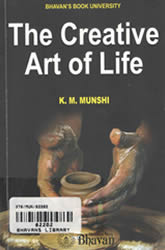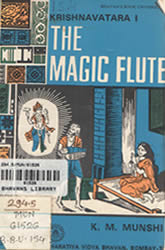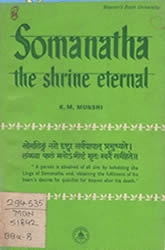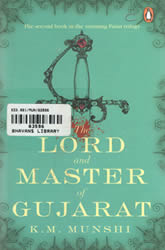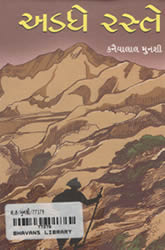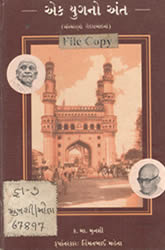
My Account | Online Catalogue | Contact Us
Munshi Saraswati Mandir Granthagar
(THE BHAVAN'S LIBRARY)
K M Munshi Collection
Collection of books by and on Kulapati K M Munshi are available.
Browse K M Munshi Collection
Library Blog
Articles: Sanskrit through the ages
Author: Kulapati K.M. MunshiSource: Bhavan's Journal, September 19, 1971
I am very happy that some recognition, though belated has been given to Sanskrit by the Government of India. At the suggestion of the Central Government, Sanskrit Day was recently observed all over India.
It is a happy coincidence that the day chosen was the Upakarma day or Shravani, the auspicious day which our ancestors fixed, thousands of years ago, for the commencement of the study of the Vedas. It Augurs well for the land because a right step, quite consistent with the historical forces that have been shaping the destiny of our land has been taken.
The Bhavan and the Sanskrit Vishva Parishad, sponsored and run by it, stand for the resuscitation of Sanskrit. With Sanskrit is bound up the unique continuity of our culture and the unity, integrity and vitality of India. More, in all those whose parents have an acquaintance with Sanskrit, it lays and strengthens the foundations of a purposive life nationally and internationally.
Our ancestors were a highly forward-looking people. Five thousand years ago, they set for mankind the ideal of the One World-Vasudhaiva Kutumbakam and prayed for the welfare of all: Lokah Samastah sukhino bhavanu.
I propose to share with you my reflections on Sanskrit through the ages, tracing it form the earliest times in the hymns of the Vedas through its days of glory in the days of Imperial Magadha and Guptas its later hibernation and subsequent revival.
Of all the forces which bind man and make him a social and cultural being, the most powerful is the word. In that sense, the worship of the word, Sabda-Brahma, is one of the most pervasive forces of life. For instance, geographically, India owes everything to the Himalayas; in the sphere of social relations, as also in the sphere of the mind and the spirit, India owes everything to Sanskrit.
In pre-historic times, the early Aryans forged the Aryan language, the ancestor of many Indo-European languages. In the course of this process, certain ideas came to be compressed in words of fateful meaning; in the progress of time these words moulded the social, intellectual and spiritual life of the human race.
In the India the Aryans used the word in the primary Prakrit which they spoke, and which later became Classical Sanskrit, with extraordinary sanctity. This happened long before the Dasharajna, the Battle of Ten Kings, the great historical event recorded in the Rigveda. The Aryan tribes fought each other and fought against the non-Aryan Dasyus; but they were bound together by the spoken word.
When the words came out in rhythmic chants they were mantras, divinities in themselves. Those who could compose the mantras were demi-gods, deserving worship. People believed the perfect Word to be a divinity, and the man who commanded it, half divine. It was this belief which made Sanskrit in its infancy a living bond between different minds and tribes.
The Aryans spoke Sanskrit; whoever came to speak that language was elect; culture could be acquired only through it. This idea has been at the root of all that followed in India’s varied history. Rigvedic mantras were stylized lyrical poems intended to invest rituals with greater efficacy; but from the earliest mantras to latest tenth Mandalas, there are clear indications that the language was not far remote from the spoken language and was undergoing progressive change by use. But it was the mantras which kept together. The Atharvaveda, though as old as the Rigveda in substance, was in form a later composition, composed at a time when the spoken language was not very different from that of the time of the grammarian Pantanjali; but the hymns when canonised were given the garb of mantras.
The Brahmanas again are described as the only genuine prose works in Sanskrit as a popular language now available. The Upanishads were also the vehicle of living thought in the dialect of the teachers and the pupil.
During the centuries which elapsed between the emergence of a dominant Aryan Power in the sapta-sindhu and the battle of the Mahabharata in about 1500B.C., the primary Prakrit as the spoken language of the people evolved to very near classical Sanskrit. It was recognized as the great unifying force, for the central idea of Aryan culture was Rita-the overall law of life; and Sanskrit was Rita in action, unifying, uplifting and bringing one nearer to the Gods.
II
From the Bharata War to the rise of the Magadhan Power (1500 B.C. to 700 B.C.), when authentic history begins, this idea took hold of the collective unconscious of the race. Sanskrit was not merely a powerful living language in daily use among the people living in the valley of the Sindhu and the Ganga and their tributaries. It was the language of literature, philosophy and law, which the gods would listen. It was best spoken in the Madhya Desh where the sacred Brahmins lived and taught in the hermitages which had been progressively pushing forward the frontiers of Aryavarta towards the east and the south. Whenever Sanskrit was spoken and taught there was Aryavarta.
III
Rigveda mantras have become the divine Words, divinities with mystic power to be worshiped in their sound and accent alone; the Rock of Ages, to which all life turned for inspiration; the concentrated symbol and embodiment of the Spirit of all life. Ritualistic literature was sacrosanct.
The Mahabharata was growing into a wide literature of life, expressing epic heroism; legends of kings and rishis, sacred rivers and holy places; wise’ lessons in practical wisdom and philosophic and moral speculations resulting from man’s efforts to attain the Divine, The akhyanas were composed by poets and narrators for the popular audiences of the time; some of the legends were taken from current folk stories. For many centuries after they were composed, they were recited in courts and halls and gatherings of men to inspire or to point a moral.
The Dharmasutra literature and the Manusmriti, the oldest law text, were for the use of the people who spoke the language. The Upanishads and the Bhagavad-Gita, the original of which was composed long before the seventh century B.C., embodied the intellectual speculations of the day. During these 800 odd years, Sanskrit evolved vigorously not only as the spoken and literary language of a vast educated public and the vehicle of higher intellectual, aesthetic and scientific expression, but also as the instrument of Aryan culture which was spreading far and wide, uplifting and moulding the different races.
Recommendations
... and many more.
Library Blog
Contributions like articles, book reviews, book abstracts, etc. are welcome from Library Members, Bhavan’s staff, and friends and supporters of the Library.
Contribute to Library BlogUseful Website Links
- eBooks and Literature
Join Now
- Patron -1 [25 Years]
- Patron -2 [15 Years]
- Bookworm [Yearly]
